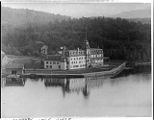Usuario:Tmmfernanda/Taller

Lago Saranac Inferior es uno de los tres lagos conectados (Lago Saranac Inferior, Medio y Superior) , parte del Río Saranac, cerca de las montañas de Adirondacks al Norte de Nueva York. Las Islas públicas del Lago Saranac Inferior y Medio ofrecen 87 lugares para acampar. También es alimentado por el Lago Colby, Fish Creek, y Lilly Pad Pond. El Lago Saranac Inferior está localizado en Harrietstown, Nueva York.
Historia[editar]
Antes del desarrollo de los ferrocarriles y automobiles el Lago Saranac formaba parte de una importante ruta de transportación en Adirondacks; se podía viajar 225, 30816 km de Old Forge al Lago Champlain casi todo por agua. En 1849, William F. Martin construyó uno de los primeros hoteles en Adirondacks, llamado "Saranac Lake House" y hoy en día solo "Martin's"built — en la orilla noreste del Lago Saranac Inferior. Martin's, con espacio para 80 huéspedes, se convirtió en el lugar favorito para cazadores, leñadores, y grupos de personas que se reunían para interactuar; el joven Theodore Roosvelt estaba entre los huéspedes[1] y los miembros del famoso "Philosopher's Camp" en Follensby Pond (incluyendo a poetas como Ralph Waldo Emerson y James Russell Lowell y científicos como Louis Agassiz) encontrando sus guías en "Martin's"[2] . The publication of William H. H. Murray's Adventures in the Wilderness; Or Camp-Life in the Adirondacks in 1869, containing a favorable review of Martin's, started a flood of tourists to the area, leading to a rash of hotel building and the development of stage coach lines. In 1892, Dr. William Seward Webb's Mohawk and Malone Railway reached the village of Saranac Lake; it dramatically reduced travel time from major east coast cities to the Adirondacks, and had a major impact on the hotel and the area. In 1870, the hotel's capacity was doubled. In 1880, Martin lost the hotel through foreclosure. The new owner promptly remodeled and increased capacity to 250 guests. In 1888, it underwent its final renovations, but in 1894, it burned to the ground.
In 1884, a new hotel was built half a mile southeast of Martins. Known originally as Alexander's or the Alexander House, with a capacity for one hundred guests, in 1890, it changed hands and was renamed The Algonquin. It quickly established a reputation for luxury, modern technology, and fine cuisine, and the capacity was soon raised to 150. In 1914, the hotel was leased to a firm that tried using it as a tuberculosis sanatorium, an innovation that failed the first year. Although it resumed operation as a hotel, it never did well again, changing hands several times, ultimately becoming the property of Edmond Guggenheim, who owned property nearby; he donated it to the Trudeau Institute, which replaced the structure with their present building in the late 1950s.
In 1888, a third hotel was built at the northern end of the lake, this on the western shore of Ampersand bay, the Hotel Ampersand. Originally conceived as a year-round health resort, banking on Saranac Lake's reputation for the treatment of tuberculosis, instead it found its best clientele to be healthy summer vacationers. The largest and most fashionable of the three hotels, it was dubbed the Saratoga of Lower Saranac Lake. It was saved from the slow decline of its neighbors by a spectacular fire in 1907. It was never rebuilt.
As the state owned much of the shoreline of Lower Saranac Lake, there is much less development there than on Upper Saranac Lake. One notable property is the Knollwood Club, built in 1899-1900 by local architect William L. Coulter for six friends, including Louis Marshall and Daniel Guggenheim. Louis Marshall's sons wilderness activist Bob Marshall and conservationist George Marshall spent the summers of their youth there,[3] and Albert Einstein was a frequent summer visitor;[4] he was at Knollwood on August 6, 1945 when he heard on the radio that that atom bomb had been dropped on Hiroshima. Einstein enjoyed sailing on the lake, and on occasion needed to be rescued by local residents after capsizing.[5]
-
Shingle Bay
-
A mink, near Fish Creek
-
Saranac Lake House, 1890 (Stoddard)
-
Hotel Ampersand, 1890 (Stoddard)
-
The Algonquin (c. 1900 - 1910)
-
Hotel Ampersand, WH Jackson, 1902
References[editar]
- ↑ Historic Saranac Lake
- ↑ James Schlett, 6/22/2008, DailyGazette.com, "Return to the Philosophers’ Camp"
- ↑ Brown, Phil (ed). 2006. Bob Marshall in the Adirondacks. Saranac Lake, New York: Lost Pond Press. ISBN 0-9789254-0-8.
- ↑ Historic Saranac Lake
- ↑ Taylor, Robert, America's Magic Mountain, Boston: Houghton Mifflin, 1986. ISBN 0-395-37905-9
Sources[editar]
- Jamieson, Paul and Morris, Donald, Adirondack Canoe Waters, North Flow, Lake George, NY: Adirondack Mountain Club, 1987. ISBN 0-935272-43-7.
- Tolles, Bryant F., Jr., Resort Hotels of the Adirondacks, Lebanon NH: University Press of New England, 2003. ISBN 1-58465-096-6.







